Welcome to my comprehensive guide on indoor organic gardening for beginners! Discover easy, eco-friendly ways to grow fresh produce at home. With the right knowledge and techniques, you can create a thriving garden right in the comfort of your own space. Whether you have a small apartment or a spacious house, indoor organic gardening is a rewarding and sustainable practice that allows you to enjoy the benefits of homegrown vegetables all year round.
Key Takeaways:
- Indoor organic gardening is a sustainable and rewarding practice.
- With the right knowledge and techniques, beginners can successfully grow fresh produce indoors.
- Indoor organic gardening is suitable for small spaces, including apartments and houses.
- Choosing the right plants and creating an optimal growing environment are essential for success.
- Regular care and maintenance practices, such as watering and pest control, are necessary for a healthy indoor garden.
Why Choose Indoor Organic Gardening?
If you’re new to gardening and want to grow your own fresh produce, indoor organic gardening is the perfect choice. Let me explain why.
First and foremost, indoor organic gardening allows you to have complete control over the growing conditions of your plants. Unlike outdoor gardening, where you have to rely on unpredictable weather and natural factors, indoor gardening allows you to create an ideal environment for your plants to thrive. You can adjust factors such as lighting, temperature, and humidity to ensure optimal growth.
Another reason to choose indoor organic gardening is that it enables you to grow your own food year-round. With indoor gardening, you’re not limited by seasonal changes or harsh climates. You can enjoy fresh, homegrown vegetables and herbs regardless of the time of year. This not only saves you money but also ensures that you have access to nutritious produce whenever you need it.
Furthermore, indoor organic gardening is a space-efficient option, especially if you have limited outdoor space or live in an apartment. You can set up a small garden on a windowsill, a shelf, or even use vertical gardening techniques to maximize your space. This makes it accessible to anyone, regardless of the size of their living area.

In conclusion, indoor organic gardening provides several benefits for beginners. It allows you to have control over growing conditions, enables year-round gardening, and is space-efficient. So why not embark on this rewarding journey of growing your own fresh, organic produce indoors?
Getting Started with Indoor Organic Gardening
Now that you’re excited about indoor organic gardening, let’s dive into the steps you need to take to get started. Indoor gardening has become increasingly popular, allowing gardeners to enjoy fresh produce year-round and create a green oasis in their homes. Whether you have limited outdoor space, want to extend your growing season, or simply love the idea of having plants indoors, indoor organic gardening is a rewarding and fulfilling hobby.
The first step in starting your indoor garden is to gather the essential tools and equipment. Here’s a list of indoor gardening essentials:
- Containers or pots: Choose pots that have good drainage and are the appropriate size for your plants.
- Organic potting soil: Opt for high-quality organic potting soil that is nutrient-rich and free from chemicals.
- Seeds or seedlings: Select seeds or seedlings of plants that are suitable for indoor gardening, such as herbs, leafy greens, or dwarf varieties of vegetables.
- Watering can or spray bottle: Provide your plants with the right amount of water using a watering can or spray bottle.
- Natural fertilizers: Use organic fertilizers to nourish your plants and promote healthy growth.
- Grow lights: Supplement natural light with artificial grow lights, especially if you have limited access to sunlight.
Once you have the necessary tools and equipment, the next step is to choose the right location for your indoor garden. Look for a spot in your home that receives adequate sunlight or is easily accessible to artificial grow lights. Consider the temperature and humidity levels of the chosen location, as different plants have specific requirements.
Remember to start small and gradually expand your indoor garden as you gain more experience. It’s also important to stay consistent with watering, fertilizing, and providing the necessary care for your plants. With dedication and patience, you’ll soon be enjoying a bountiful harvest from your indoor organic garden.
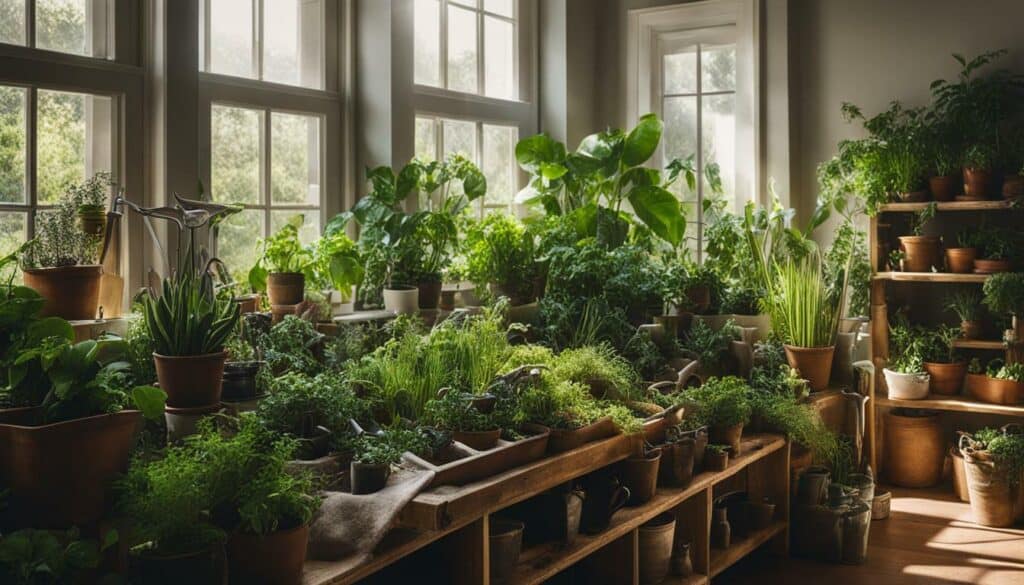
Inspiring Indoor Garden Setup
| Plants | Lighting | Location |
|---|---|---|
| Herbs | Natural sunlight supplemented with grow lights | Kitchen windowsill |
| Lettuce | LED grow lights | Shelving unit in living room |
| Tomatoes | High-output fluorescent lights | Indoor greenhouse |
Choosing the Right Plants for Indoor Organic Gardening
One of the keys to successful indoor organic gardening is choosing the right plants that will thrive in your limited space. When it comes to indoor gardening, space is often a constraint. However, with careful planning and selection, you can create a bountiful indoor garden even in small spaces. Here are some beginner-friendly plants that are perfect for indoor organic gardening in small spaces:
- Herbs: Herbs like basil, thyme, and mint are excellent choices for indoor gardening. They require minimal space and can be grown in small pots or even vertical planters.
- Leafy greens: Plants like lettuce, spinach, and kale are ideal for indoor gardening. They grow quickly and can be harvested multiple times, ensuring a constant supply of fresh greens.
- Microgreens: Microgreens are young, tender greens that are packed with nutrients. They are easy to grow and mature quickly, making them a great choice for beginners.
- Scallions: Scallions, also known as green onions, are compact and can be grown in small containers. They add a delicious flavor to various dishes and can be continuously harvested by cutting just the green part.
- Succulents: If you’re looking for low-maintenance plants, succulents are a great option. They come in various shapes and sizes, adding a touch of greenery to your indoor space.
Remember to consider the lighting requirements of the plants you choose. Most indoor plants require at least 6 hours of sunlight or artificial light per day. If your space lacks natural light, you can supplement it with grow lights specifically designed for plants.
Choosing the Right Containers
In addition to selecting the right plants, choosing suitable containers is essential for successful indoor gardening. Consider the following factors when selecting containers:
- Size: Make sure the containers are large enough to accommodate the mature size of the plants and their root systems.
- Drainage: Ensure that the containers have drainage holes to prevent waterlogged soil, which can lead to root rot.
- Material: Opt for containers made of breathable materials like terracotta or fabric, as they allow for better airflow and water drainage.
With the right selection of plants and containers, you can create a thriving indoor organic garden, even in the smallest of spaces. Enjoy the satisfaction of growing your own fresh produce and adding a touch of greenery to your home!
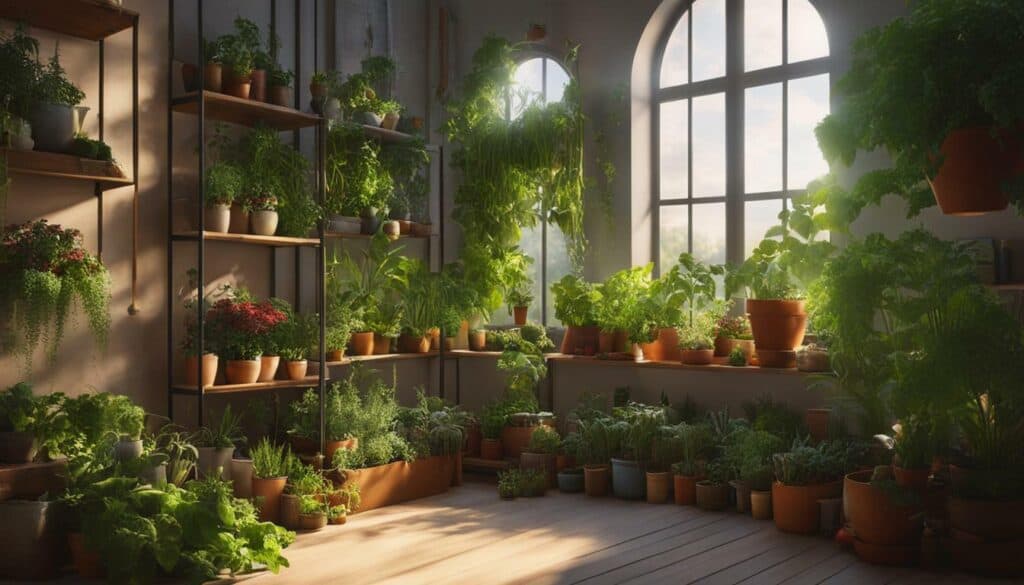
| Plant | Light Requirements | Space Requirements |
|---|---|---|
| Basil | 6-8 hours of sunlight or artificial light per day | Small pot or vertical planter |
| Lettuce | 6-8 hours of sunlight or artificial light per day | Shallow container |
| Spinach | 6-8 hours of sunlight or artificial light per day | Shallow container |
| Kale | 6-8 hours of sunlight or artificial light per day | Small pot or vertical planter |
| Microgreens | 6-8 hours of sunlight or artificial light per day | Shallow container |
| Scallions | 6-8 hours of sunlight or artificial light per day | Small pot or vertical planter |
| Succulents | 4-6 hours of sunlight or artificial light per day | Small pot or decorative container |
Creating the Ideal Indoor Growing Environment
To ensure your indoor organic garden flourishes, it’s crucial to create the perfect growing environment for your plants. Indoor gardening techniques and hacks can help you provide optimal conditions that mimic the outdoors.
First, let’s talk about lighting. Since natural sunlight may not always be sufficient, you can use artificial grow lights to supplement or replace sunlight. LED grow lights are energy-efficient and effective for promoting plant growth. Place the lights at an appropriate distance from the plants, ensuring they receive the right amount of light for each growth stage.
Next, it’s essential to maintain the ideal temperature and humidity levels. Most indoor plants thrive in temperatures between 65-75°F (18-24°C) during the day and slightly lower at night. Use a thermometer to monitor the temperature and adjust as necessary. As for humidity, consider misting the plants regularly or using a humidifier to provide the required moisture.
Ventilation is another crucial factor in indoor gardening. Good airflow helps prevent mold, mildew, and stagnant air. You can achieve this by using small fans or opening windows periodically to promote fresh air circulation.
Indoor Gardening Hacks
- Consider using reflective materials like mirrors or foil behind your plants to maximize light absorption.
- Create a watering schedule and stick to it. Overwatering can lead to root rot, while underwatering may cause plants to wither. Find the right balance.
- Add organic fertilizers or compost to enrich the soil and provide essential nutrients to your plants.
- Repurpose household items like egg cartons or yogurt cups as seed starters.
“Creating the perfect indoor growing environment is the key to success in indoor organic gardening. By fine-tuning the lighting, temperature, humidity, and ventilation, you’ll be able to cultivate healthy and thriving plants all year round.” – Joe Lamp’l
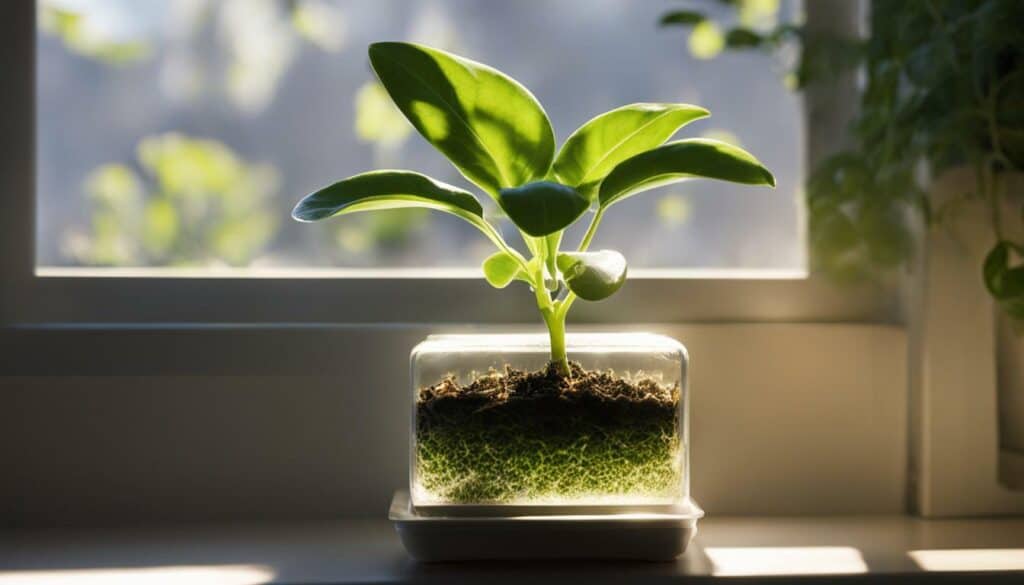
| Plant | Light Requirements | Temperature Range |
|---|---|---|
| Tomatoes | Direct sunlight or 8-10 hours of artificial light | 70-85°F (21-29°C) |
| Basil | 6-8 hours of direct or artificial light | 60-75°F (15-24°C) |
| Succulents | 6-8 hours of bright, indirect light | 60-80°F (15-27°C) |
Remember, each plant has specific requirements, so research and adjust your indoor gardening techniques accordingly. With a little care and attention, you can create a flourishing indoor organic garden that brings joy and fresh produce to your home.
Nurturing and Maintaining Your Indoor Garden
Now that your indoor garden is set up, it’s time to nurture and maintain it to ensure bountiful harvests. Taking proper care of your plants is crucial for their growth and overall health. Here are some essential tips and techniques for maintaining your indoor organic garden.
Provide Adequate Watering
Watering is one of the most important tasks in indoor gardening. Each plant has different water requirements, so it’s essential to understand the needs of your specific plants. Avoid overwatering, as it can lead to root rot and other diseases. Conversely, underwatering can cause wilting and stunted growth.
Monitor the moisture level of the soil regularly and adjust your watering schedule accordingly. A simple way to check is by inserting your finger about an inch into the soil. If it feels dry, it’s time to water. Consider using a self-watering system or water trays to maintain consistent moisture levels.
Remember that water quality is also crucial for the health of your plants. Use filtered or dechlorinated water, as tap water may contain chemicals that can harm your plants over time. Additionally, avoid wetting the leaves when watering, as it can lead to fungal diseases.
When it comes to fertilizing your indoor garden, organic options are highly recommended. They provide essential nutrients in a natural and sustainable way. Choose a balanced organic fertilizer or make your own compost tea using kitchen scraps. Apply the fertilizers according to the instructions on the package or as needed by your plants.
Regularly inspect your indoor garden for any signs of pests or diseases. Common pests include aphids, spider mites, and fungus gnats. If you spot any unwanted visitors, take immediate action to prevent them from spreading and damaging your plants.
There are various organic pest control methods you can use, such as introducing beneficial insects like ladybugs or using neem oil sprays. For small infestations, you can manually remove the pests using a soft cloth or sponge. Always research the specific pest and appropriate control methods to ensure the safety of your plants.
The key to successful indoor organic gardening is consistency and observation. By following these tips and techniques, you can create a thriving indoor garden that provides you with fresh and healthy produce all year round.
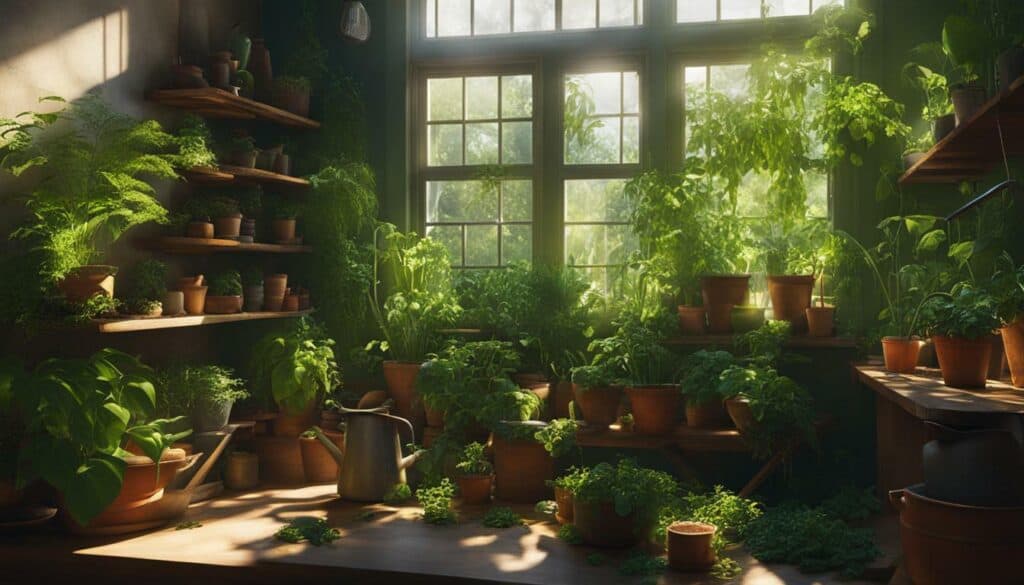
| Plant | Watering Frequency | Light Requirements | Temperature Range |
|---|---|---|---|
| Tomatoes | Every 2-3 days | Full sun (6-8 hours) | 60-85°F (15-29°C) |
| Lettuce | Every 1-2 days | Partial shade (4-6 hours) | 45-75°F (7-24°C) |
| Herbs (Basil, Parsley, etc.) | Every 2-3 days | Partial shade (4-6 hours) | 60-70°F (15-21°C) |
| Microgreens | Every 1-2 days | Partial shade (4-6 hours) | 60-70°F (15-21°C) |
Harvesting and Enjoying Your Indoor Organic Produce
The moment you’ve been waiting for has arrived – it’s time to harvest and savor the delicious rewards of your indoor organic garden. After all the hard work and dedication you’ve put into nurturing your plants, it’s incredibly satisfying to finally enjoy the fruits (or vegetables) of your labor.
To ensure that you harvest your produce at the peak of freshness and flavor, it’s important to pay attention to the signs of readiness for each specific crop. For example, tomatoes should be harvested when they are fully ripe and vibrant in color, while lettuce and herbs can be harvested when the leaves are young and tender.
When harvesting, use clean and sharp gardening shears or scissors to make clean cuts without damaging the plant. It’s important to harvest in the morning when the plants are well-hydrated, as this will help your produce retain maximum freshness and flavor. Remember to wash your harvested produce thoroughly before consuming.
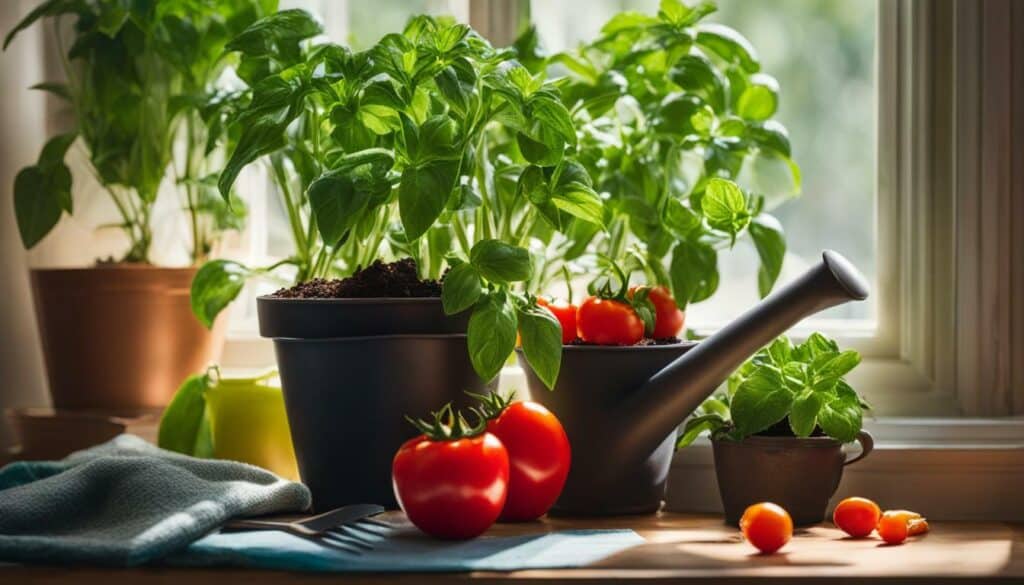
Harvesting Tips:
- Harvest ripe fruits and vegetables to ensure the best flavor and nutritional value.
- Use clean and sharp gardening shears or scissors for clean cuts.
- Harvest in the morning when plants are well-hydrated for maximum freshness.
- Wash harvested produce thoroughly before consuming.
Delicious Recipes Using Your Indoor Organic Produce
“There’s nothing quite like the satisfaction of cooking a meal using fresh ingredients from your own indoor garden. From flavorful salads packed with nutrient-rich greens to mouthwatering stews bursting with homegrown herbs, the possibilities are endless. Explore new recipes that make the most of your indoor organic produce and delight your taste buds.”
| Recipe | Ingredients | Preparation Time |
|---|---|---|
| Caprese Salad | Tomatoes, fresh mozzarella, basil, olive oil, balsamic vinegar, salt, and pepper | 15 minutes |
| Herb-Roasted Chicken | Chicken breasts, fresh herbs (such as rosemary, thyme, and sage), garlic, olive oil, salt, and pepper | 45 minutes |
| Spinach and Mushroom Omelette | Spinach, mushrooms, eggs, cheese, salt, and pepper | 20 minutes |
Troubleshooting Common Indoor Gardening Issues
Despite your best efforts, sometimes problems can arise in your indoor garden. Don’t worry, I’ve got you covered with expert troubleshooting advice. Here are some common issues you may encounter and how to address them:
Pest Infestation:
One of the most common problems in indoor gardening is pest infestation. Pests like aphids, spider mites, and whiteflies can wreak havoc on your plants. To combat this, regularly inspect your plants for any signs of pests. If you spot them, try using natural remedies like neem oil or insecticidal soap. You can also introduce beneficial insects like ladybugs or predatory mites to control the pest population.
Yellowing Leaves:
If you notice that the leaves of your indoor plants are turning yellow, it could be a sign of nutrient deficiency or overwatering. Check the soil moisture level and adjust your watering accordingly. Also, make sure you are providing the right amount of nutrients. Use a balanced organic fertilizer and follow the recommended dosage. If the problem persists, you may need to repot your plants and examine the roots for any issues.
Fungus and Mold:
Fungus and mold can thrive in the moist environment of an indoor garden. To prevent this, ensure proper air circulation and avoid overwatering your plants. If you spot any signs of fungus or mold, remove the affected leaves or plants immediately. You can also use a natural fungicide like diluted hydrogen peroxide or cinnamon powder to control the spread.
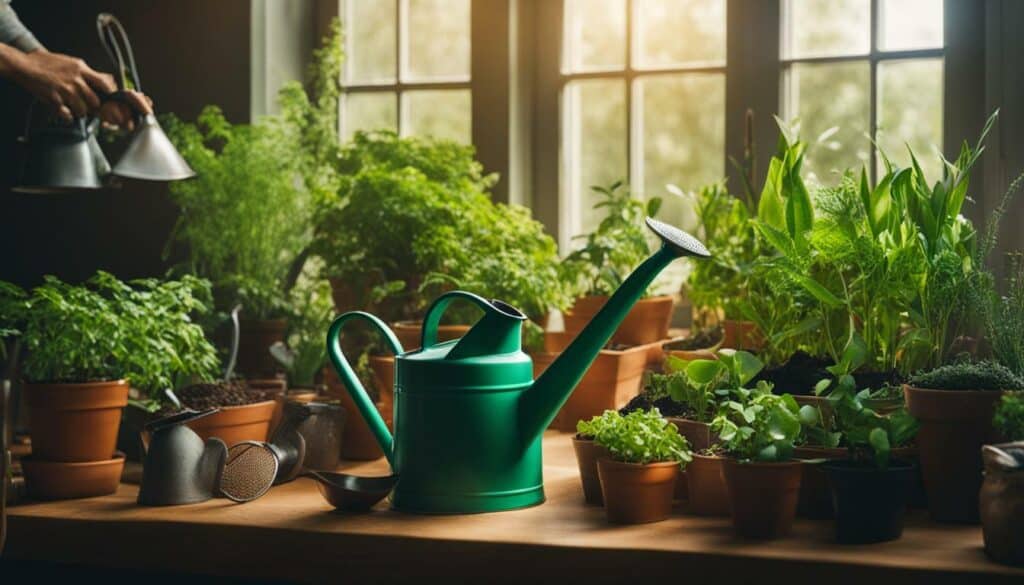
Remember, troubleshooting issues in your indoor garden is part of the learning process. By staying observant and taking prompt action, you can ensure the health and success of your indoor plants. Happy gardening!
| Issue | Troubleshooting Tips |
|---|---|
| Pest Infestation | – Regularly inspect plants for pests – Use natural remedies or beneficial insects – Maintain proper plant hygiene |
| Yellowing Leaves | – Check soil moisture and adjust watering – Provide balanced organic fertilizer – Repot if necessary and examine roots |
| Fungus and Mold | – Ensure proper air circulation – Avoid overwatering – Remove affected leaves or plants – Use natural fungicides |
Learning Resources for Further Indoor Organic Gardening Education
Ready to take your indoor organic gardening skills to the next level? Explore these fantastic resources for further education and inspiration.
If you’re looking for in-depth knowledge and practical guidance on indoor organic gardening, the Master Indoor Organic Gardening for Beginners: A Comprehensive Guide course by national gardening expert Joe Lamp’l is a must-have resource. This comprehensive course provides step-by-step instructions on starting, growing, nurturing, and harvesting vegetables indoors. Although enrollment is currently closed, keep an eye out for its reopening in late March.
To enhance your indoor gardening skills further, consider reading the book “Indoor Kitchen Gardening: A Complete Guide On Organic Gardening For Homesteading Indoors” by Dean Simpson. This DIY gardening guide offers valuable insights into creating a mini garden at home. Simpson provides expert advice on selecting the right plants, maintaining an optimal indoor environment, and utilizing space effectively.
Exploring online communities and forums dedicated to indoor gardening can also be a great way to connect with fellow gardening enthusiasts and gain valuable knowledge. Websites like indoorgardening.com and gardenweb.com offer forums, articles, and resources specifically tailored to indoor gardening techniques, providing a wealth of information and inspiration.
| Learning Resources | Description |
|---|---|
| The Master Indoor Organic Gardening for Beginners: A Comprehensive Guide | A course by Joe Lamp’l covering all aspects of indoor organic gardening. |
| Indoor Kitchen Gardening: A Complete Guide On Organic Gardening For Homesteading Indoors | A book by Dean Simpson offering insight into mastering indoor kitchen gardening. |
| indoorgardening.com | An online community and resource hub for indoor gardening enthusiasts. |
| gardenweb.com | A platform providing forums, articles, and resources dedicated to indoor gardening techniques. |
By immersing yourself in these learning resources and engaging with the indoor gardening community, you’ll be well-equipped to take your indoor organic gardening skills to new heights!
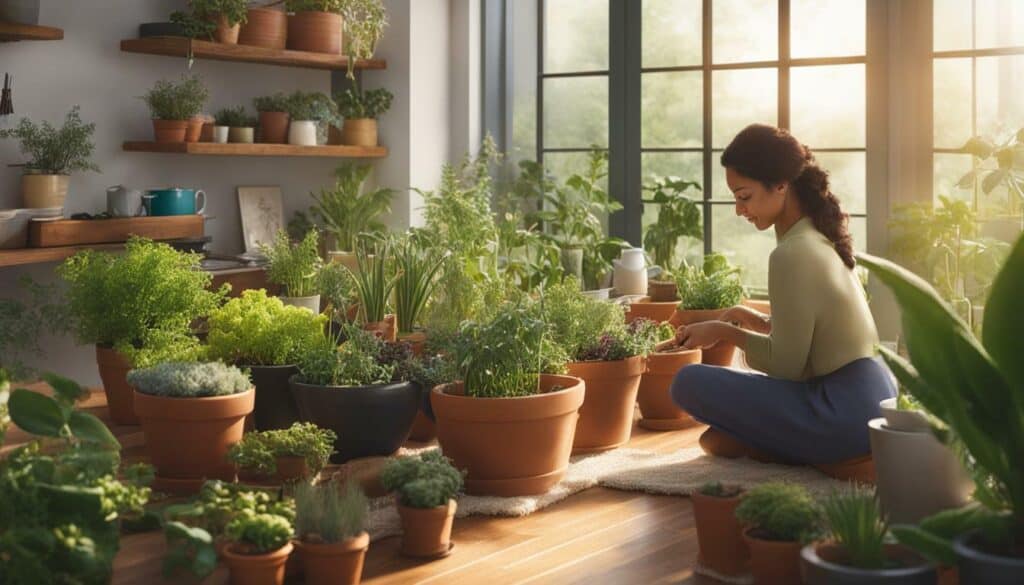
Success Stories and Inspiring Indoor Gardens
Get inspired by these incredible success stories and stunning indoor gardens that prove anyone can become a successful indoor organic gardener. Whether you have limited space, a lack of experience, or simply a desire to bring nature indoors, these stories and gardens will show you the endless possibilities of indoor organic gardening.
One of the remarkable success stories is Lisa, a beginner who transformed her small apartment balcony into a thriving garden oasis. With a variety of herbs, lettuce, and cherry tomatoes, she not only beautified her space but also enjoyed a bountiful harvest all year round. Her secret? Regular monitoring, organic fertilizers, and a DIY vertical garden system, which maximized her limited space.
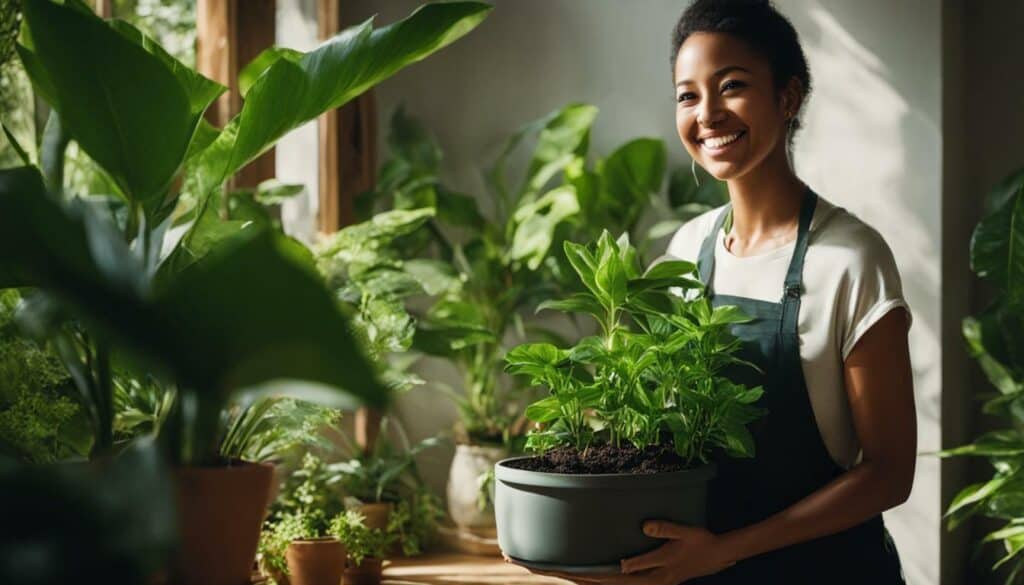
Another inspiring garden is Michael’s indoor hydroponic setup. With a simple, self-built system and a passion for sustainable living, Michael grew an abundance of leafy greens and herbs in a compact corner of his kitchen. By carefully controlling the water, lighting, and nutrient levels, he achieved remarkable growth rates and flavors that surpassed store-bought produce.
Now, let’s take a look at a few stunning indoor garden designs that will leave you in awe. Emily’s hanging herb garden, featuring a unique macrame display, adds a touch of elegance to her kitchen while providing fresh seasonings for her culinary creations. Sarah’s vertical living wall, filled with vibrant tropical plants, creates a breathtaking focal point in her living room, turning her urban apartment into a lush oasis.
| Success Stories | Inspiring Indoor Gardens |
|---|---|
| Lisa’s balcony garden | Emily’s macrame herb garden |
| Michael’s hydroponic setup | Sarah’s vertical living wall |
These stories and gardens are just a glimpse into the world of indoor organic gardening. With a little creativity, dedication, and the right knowledge, you too can create your own indoor garden paradise. So, why wait? Start your journey towards becoming a successful indoor organic gardener today!
Conclusion
Congratulations on completing this comprehensive guide on indoor organic gardening for beginners. Now you have the knowledge and tools to embark on your own indoor gardening journey and enjoy fresh, organic produce right at home.
Throughout this guide, we have covered the benefits of indoor organic gardening, the essential steps to get started, and how to create the ideal growing environment. We have also provided tips on nurturing and maintaining your indoor garden, as well as troubleshooting common issues that may arise.
Remember, indoor organic gardening is not only a rewarding and fulfilling hobby but also a sustainable and healthy way to grow your own food. By choosing organic methods, you are not only reducing your exposure to harmful chemicals but also supporting a more environmentally friendly approach to gardening.
As you begin your indoor gardening journey, don’t hesitate to seek further education and resources. There are many books, online courses, websites, and communities available to help you deepen your knowledge and expand your skills.
So, start gathering your supplies, choose the perfect plants for your indoor space, and let your green thumb flourish. With dedication and patience, you will soon be enjoying the bountiful harvest of your indoor organic garden. Happy gardening!
FAQ
Q: Is the course currently open for enrollment?
A: No, the course is currently closed for enrollment and will reopen in late March.
Q: Is there a book available on indoor kitchen gardening?
A: Yes, there is a book titled “Indoor Kitchen Gardening: A Complete Guide On Organic Gardening For Homesteading Indoors” by Dean Simpson.
Q: What does the book cover?
A: The book offers insight into mastering indoor kitchen gardening and serves as a DIY gardening guide for creating a mini garden at home.

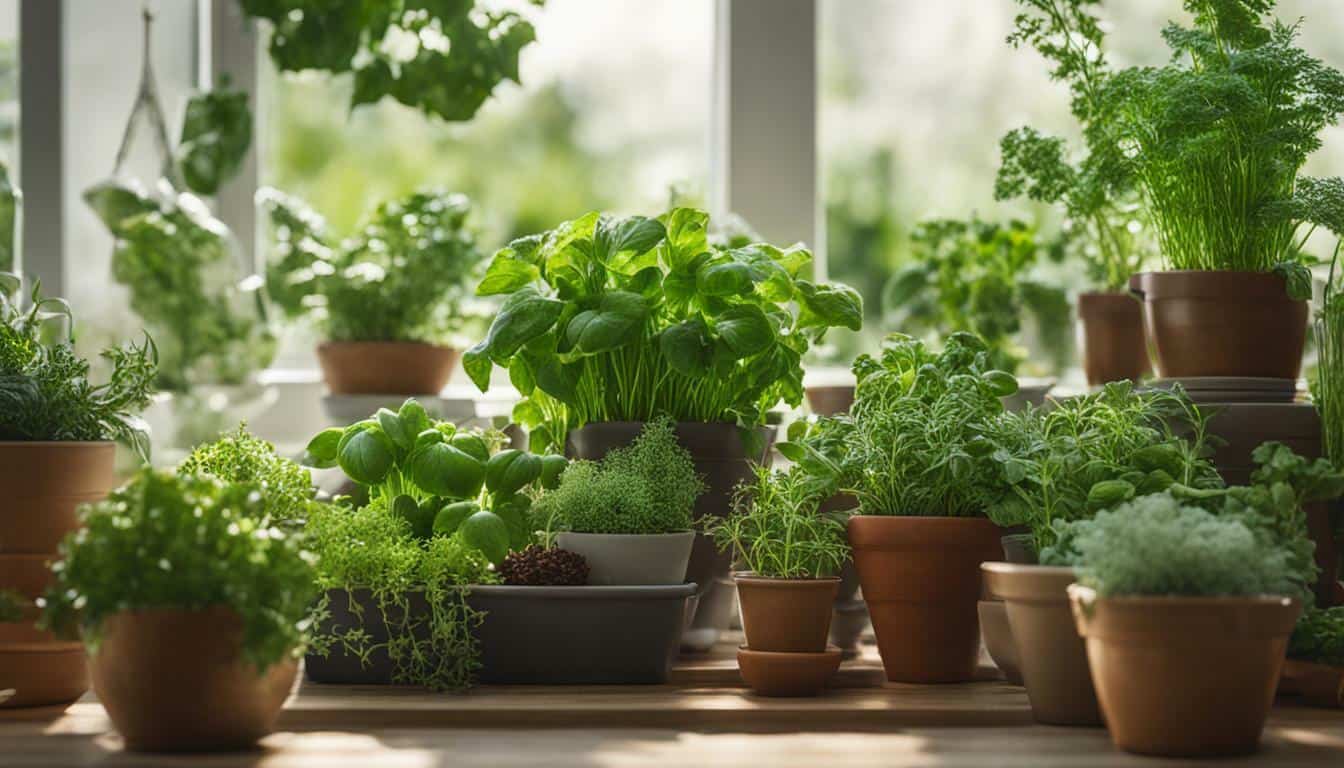



Leave a Reply